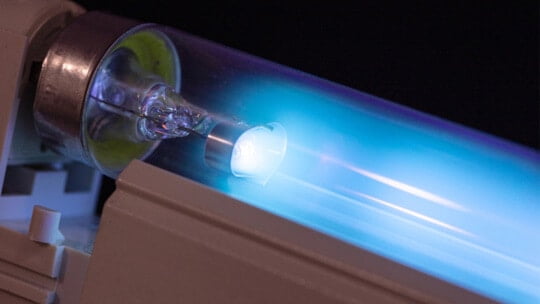Exposure To Ultraviolet (UV) Light
Table of Contents
EXPOSURE TO ULTRAVIOLET(UV) LIGHT
UV radiation is a type of electromagnetic radiation emitted by the sun and man-made sources such as tanning beds and welding torches. The emission (sending out) of energy from any source is referred to as radiation. There are many different types of radiation, ranging from extremely high-energy (high-frequency) radiation – such as x-rays and gamma rays – to extremely low-energy (low-frequency) radiation – such as radio waves. UV rays are located in the center of this spectrum. They contain more energy than visible light but less than x-rays. UV rays can also be classified according to their energy level. Higher-energy ultraviolet (UV) rays are a type of ionizing radiation. This means they have enough energy to remove an electron from an atom or molecule (ionize it). Ionizing radiation can cause DNA (genes) damage in cells, which can lead to cancer. However, even the most powerful UV rays lack the energy to penetrate deeply into the body, so their main effect is on the skin.
Types Of UV
UV radiation is classified into three types: UVA rays have the least amount of energy of any UV ray. These rays can cause skin cells to age and cause some indirect DNA damage. UVA rays are primarily associated with long-term skin damage such as wrinkles, but they may also play a role in some skin cancers. UVB rays have a slightly higher energy level than UVA rays. They are the primary rays that cause sunburns because they can directly damage the DNA in skin cells. They are also thought to be the root cause of the majority of skin cancers. UVC rays are more powerful than other types of UV rays. Fortunately, as a result of this, they react with the high levels of ozone in our atmosphere and do not reach the ground. However, UVC rays can also be emitted by man-made sources such as arc welding torches, mercury lamps, and UV sanitizing bulbs used to kill bacteria and other germs (such as in water, air, food, or on surfaces) Even though UV rays account for a small portion of the sun’s rays, sunlight is the primary source of UV radiation. UV rays of various wavelengths reach the ground in varying amounts. About 95 percent of the UV rays from the sun that reach the ground are UVA rays, with the remaining 5 percent being UVB rays.

Exposure To UV
The strength of UV rays reaching the ground is determined by a number of factors, including:
Other Subtances Of UV
People can also be exposed to UV rays from man-made sources. These are some examples: Sunlamps and sunbeds (tanning booths and tanning beds): The amount and type of UV radiation emitted by a tanning bed (or booth) depends on the lamps used, how long a person stays in the bed, and how frequently the person uses it. The majority of modern UV tanning beds emit mostly UVA rays, with the remainder being UVB. UV therapy (phototherapy): UV light treatment can help with some skin problems, such as psoriasis. The drug accumulates in the skin, making it more sensitive to UV rays. The patient is then exposed to UVA radiation. Another treatment option is to use UVB only (without a drug). UV-ray lamps: These lamps use bulbs that emit UV rays (mostly UVA). The bulb emits visible light as well, but it has a filter that blocks most of it while allowing UV rays to pass through. These purple-colored bulbs are used to view fluorescent material. Bug-zapping insect traps also use “black light,” which emits UV rays, but the bulbs use a different filter, causing them to glow blue. Mercury-vapor lamps can be used to illuminate large public areas such as streets or gyms. If they are functioning properly, they do not expose people to UV rays. They actually consist of two bulbs: an inner bulb that emits light and UV rays, and an outer bulb that filters out the UV rays. Only if the outer bulb is broken can UV exposure occur. Some mercury-vapor lamps are programmed to turn off when the outer bulb fails. Those that lack this feature should only be installed behind a protective layer or in areas where people will not be exposed if a portion of the bulb breaks. Arc lamps with high pressure xenon and xenon-mercury, plasma torches, and welding arcs: Xenon and xenon-mercury arc lamps are used as light and UV ray sources for a variety of applications, including UV “curing” (of inks, coatings, and so on), disinfection, simulating sunlight (for testing solar panels, for example), and even in some car headlights. The majority of these, along with plasma torches and welding arcs, are primarily of concern in terms of UV exposure in the workplace.
Cancer Types That Caused By UV
The majority of skin cancers are caused by UV rays in sunlight. Basal cell and squamous cell cancers (the two most common types of skin cancer) are most commonly found on sun-exposed areas of the body, and their occurrence is typically linked to lifetime sun exposure. Sun exposure is also linked to the risk of melanoma, a more serious but less common type of skin cancer, though perhaps not as strongly. Exposure to some man-made UV ray sources has also been linked to skin cancer.
Many studies have found that basal and squamous cell skin cancers are linked to certain sun-exposure behaviors, as well as a number of sun-exposure markers, such as: Recreational time spent in the sun (including going to the beach). Spending a lot of time in a swimsuit in the sun. Living in a brightly lit environment. Having suffered from severe sunburns in the past (with more sunburns linked to a higher risk). Having sun damage to the skin on the neck, such as liver spots, actinic keratoses (rough skin patches that can be precancerous), and solar elastosis (thickened, dry, wrinkled skin caused by sun exposure). Studies have also discovered links between certain behaviors and markers of sun exposure and melanoma of the skin, such as sunbathing, water sports, and vacationing in sunny places, previous sunburns, and signs of sun damage to the skin, such as liver spots, actinic keratoses, and solar elastosis.


UV rays would not be expected to cause cancer in internal organs because they do not penetrate deeply into the body, and most research has not found such links. Some studies, however, have found possible links to other cancers, such as Merkel cell carcinoma (a less common type of skin cancer) and melanoma of the eye. Tanning bed (or booth) users have a higher risk of skin cancer, including melanoma, squamous and basal cell skin cancers, according to research. Melanoma risk increases if indoor tanning begins before the age of 30 or 35, and basal and squamous cell skin cancer risk increases if indoor tanning begins before the age of 25.
The World Health Organization includes the International Agency for Research on Cancer (IARC) (WHO). One of its primary goals is to discover the causes of cancer. IARC has determined that solar radiation is carcinogenic to humans, that the use of UV-emitting tanning devices is carcinogenic to humans, and that UV radiation (including UVA, UVB, and UVC) is carcinogenic to humans based on the available data. The National Toxicology Program (NTP) is made up of components from various US government agencies, including the National Institutes of Health (NIH), the Centers for Disease Control and Prevention (CDC), and the Food and Drug Administration (FDA). The following decisions have been made by the NTP: Solar radiation is known to be a human carcinogen, as is exposure to sunlamps or sunbeds. Broad-spectrum UV radiation is also known to be a human carcinogen. UVA radiation is reasonably expected to be a human carcinogen, as is UVB radiation. UVC radiation is reasonably expected to be a human carcinogen.
In addition to skin cancer, UV rays can cause the following health problems: Sunburn can be caused by UV rays from the sun or from artificial sources such as tanning beds. UV rays can also cause premature aging of the skin and signs of sun damage such as wrinkles, leathery skin, liver spots, actinic keratosis, and solar elastosis. UV rays can also harm the eyes. They can inflame or burn the cornea (the clear front surface of the eye). They can also cause cataracts (clouding of the lens of the eye) and pterygium (tissue growth on the eye’s surface), both of which can impair vision. UV rays can also weaken the immune system, making it more difficult for the body to fight infections. This can result in issues such as herpes reactivation caused by sun exposure or other UV ray sources. It can also reduce the effectiveness of vaccines. Some people are more vulnerable to the harmful effects of UV radiation. Some medications can also make you more sensitive to UV radiation, increasing your chances of getting sunburned. UV radiation can also aggravate certain medical conditions.
Vitamin D And UV
When your skin is exposed to UV rays from the sun, it naturally produces vitamin D. How much vitamin D you produce is determined by a variety of factors, including your age, skin color, and the amount of sunlight available where you live. Vitamin D has numerous health advantages. It may even help reduce the risk of certain cancers. At the moment, doctors are unsure of the optimal level of vitamin D, but much research is being conducted in this area. It is preferable to get vitamin D from your diet or supplements rather than from UV rays whenever possible. Dietary sources and vitamin supplements do not increase the risk of skin cancer and are usually more reliable ways to get the amount needed.
How Can I Avoid From UV
It’s not possible (or healthy) to avoid sunlight entirely, but there are some precautions you can take to avoid overexposure: Staying in the shade, especially during the midday hours, is one of the best ways to limit your UV exposure from sunlight if you’re going to be outside. Wear clothing that covers your arms and legs to protect your skin. Protect your head, face, and neck by wearing a hat. Wear UV-blocking sunglasses to protect your eyes and the skin around them. Apply sunscreen to exposed skin that isn’t covered by clothing.
For More Information
Please do not hesitate to contact us for more information on the subject.



